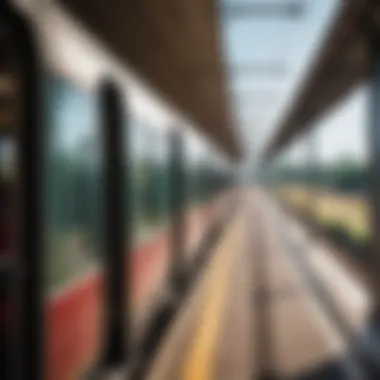Discovering Italy: Travel from Rimini to Rome


Intro
The journey from Rimini to Rome encapsulates a rich tapestry of Italian culture, history, and gastronomy. To embark on this trip is to traverse not just physical distance, but to journey through time. Rimini, with its coastal charm and vibrant nightlife, holds a deep historical significance rooted in Roman times. Meanwhile, Rome stands as the eternal city, replete with monuments witnessing the rise and fall of empires.
Understanding the nuances of traveling between these two locations enhances the overall experience. With various transportation options, travelers can choose according to their preferences—from quick train rides to leisurely road trips. Along the way, cultural landmarks beckon eager visitors, promising a quintessential Italian experience.
This guide serves as a foundational resource for tourists. It seeks to unveil the essential tips, practicalities, and hidden gems along the route from Rimini to Rome. Whether you are a seasoned traveller or new to exploring Italy, this guide will assist in making the journey more enjoyable.
Prolusion to Travel from Rimini to Rome
Traveling from Rimini to Rome is not just a journey between two cities; it's an exploration of Italian culture, history, and scenery. This route connects two significant locations that each have distinct characters yet share common threads in their heritage. Understanding this journey allows travelers to appreciate the diverse experiences available along the way.
Overview of Rimini and Rome
Rimini is located on the Adriatic coast and is famous for its stunning beaches, vibrant nightlife, and historical significance. With roots that trace back to the Romans, the city's architecture and ruins speak to its rich past. Places like the Tiberius Bridge and the Malatesta Temple are critical to understanding Rimini's historical landscape.
In contrast, Rome, the capital city, embodies thousands of years of history. It is the epicenter of art, politics, and religion in Italy. The Colosseum, Vatican City, and the Pantheon are just glimpses into what the city offers. Together, these cities provide a remarkable synthesis of experiences that reflect Italy's evolution.
Travel Significance and Popularity
Recognizing the travel significance between Rimini and Rome reveals the allure this journey holds for many foreigners and locals alike. The route not only offers practical access between two cities but also uncovers historical layers interspersed with beautiful landscapes. Each traveler may embark with different interests, whether it’s cultural, culinary, or historical pursuits.
This relationship is mirrored in the increasing popularity of the route among tourists. Transportation options like trains, buses, and car rentals have made it convenient for visitors to move between these city centers. The thriving tourism also boosts local economies and cultural exchange. By exploring this guide, you enhance your journey, ensuring you uncover the essential details that make this trip extraordinary.
"Traveling between Rimini and Rome is more than transportation; it's a journey through time and tradition."
Transportation Options
Exploring the journey from Rimini to Rome involves understanding the transportation options available. This is crucial for optimizing travel time and ensuring comfort during the trip. Multiple methods exist, each offering unique benefits and considerations. From trains to buses and car rentals, travelers must evaluate which mode aligns with their preferences and schedule.
Train Travel
Train Types and Services
Train travel between Rimini and Rome is a preferred option for many due to its efficiency and comfort. Italy’s rail system, Trenitalia, offers a variety of trains, including high-speed Frecciarossa and regional services. High-speed options significantly cut travel time, bringing Rome closer within reach. They feature comfortable seating and amenities, making long-distance travel less taxing.
Unique features of these services include the availability of onboard refreshments and the ability to book seats in advance. However, reservations might come with an additional cost.
Booking Tickets Online
The ease of booking tickets online is another compelling reason for train travel. Platforms like Trenitalia’s official website allow travelers to secure their journey from the comfort of their home. This method saves time, particularly in busy travel seasons when onsite purchases can lead to long waits.
One advantage is the ability to choose specific seats, allowing for better comfort during travel. However, this convenience can sometimes lead to confusion, particularly for non-native speakers navigating the website.
Travel Duration and Frequency
Travel duration varies between train types. Fast trains can take around three hours, while regional trains may take closer to five hours. Numerous departures throughout the day increase flexibility for travelers. Frequent services mean less stress about scheduling.
A notable point is that while regional services are more affordable, they do take longer. Therefore, balancing cost and time is key when choosing.
Bus Services
Comparative Cost of Bus vs Train
When considering budget, buses often provide a more economical choice compared to trains. Fares for bus services can be significantly lower, making it appealing for thrifty travelers. Many decide to take the bus when funds are limited, as the savings can be put towards other experiences.
The downside, however, is the longer travel time, which can be as much as seven hours. Evaluating the importance of time against cost is essential here.
Major Bus Operators


Key operators like FlixBus and MarinoBus dominate the market on this route, ensuring reliable service. These companies operate modern fleets with onboard amenities, catering to comfort during the ride. Utilizing reputable operators leads to a reasonable expectation of service quality and punctuality.
While buses lack the speed of trains, they make up for this in affordability, attracting a different audience who prioritize budget over time.
Travel Duration and Schedules
Schedules for buses may not be as frequent as trains, but they still offer several options throughout the day. Travel duration mainly depends on traffic conditions, which can vary considerably. Although travelers often anticipate delays, planning accordingly can mitigate this inconvenience.
Buses commonly take longer than trains. Thus, it is wise to check current schedules for a well-planned travel experience.
Car Rentals
Rental Process Overview
Renting a car gives travelers flexibility and control over their itinerary. The process begins by choosing a rental agency. Major brands like Hertz and Europcar operate in Rimini and provide various vehicle options. One significant advantage is the ability to explore smaller towns and attractions off the main route.
This flexibility does present challenges, such as understanding rental policies and fuel requirements, which can be complex for first-time renters.
Driving Conditions in Italy
Driving in Italy is a unique experience. Roads are well-maintained, but the driving style can be aggressive, particularly in larger cities. Tourist should be prepared for roundabouts and narrow streets in towns. Additionally, tolls on highways are common, adding to the overall travel budget.
Safety regulations are good, but being cautious is advisable. Understanding local laws and customs can enhance the driving experience.
Parking Considerations in Rome
Parking in Rome is challenging. Street parking is limited and often requires a permit. Most tourists prefer to park in garages, which can be costly. Researching options in advance and budgeting for parking is essential.
Moreover, many areas in Rome restrict vehicle access. Understanding these zones is crucial for a hassle-free journey.
Cultural Landmarks Along the Route
The journey from Rimini to Rome is not simply about getting from point A to point B, but rather about the cultural treasures that lie in between. Traveling along this route allows individuals to immerse themselves in Italy's rich history and artistic heritage. Landmarks are not just stops; they serve as connections between past and present, revealing stories that shape the identity of both cities. In this section, we delve into key stops along the way and the significant art and architecture that define the journey.
Key Stops Between Rimini and Rome
San Marino: A Brief Stop
San Marino, often regarded as the world's oldest republic, represents a unique destination for travelers. This microstate is characterized by its stunning medieval architecture and breathtaking views from the Guaita, the most famous of its three towers. The compact size of San Marino makes it an ideal stopover on the route, presenting an opportunity for exploration without substantial time commitment.
Among its highlights is the historic city center, a UNESCO World Heritage site. Visitors can enjoy delightful walks along cobblestone streets, all while being surrounded by ancient fortifications. However, while it is a enriching place to visit, one should note the potential for crowded tourist areas, especially during peak seasons.
Urbino and Its Artistic Heritage
Urbino offers a vibrant tapestry of culture and history, prominently associated with the Renaissance. The town is known for the Palazzo Ducale, a masterpiece of architectural design that houses the Galleria Nazionale delle Marche. This art gallery features significant works by artists like Raphael, who was born here.
Urbino’s charm lies in its artistic pulse and educational ethos, represented by the presence of the University of Urbino. Its status as a cultural hub makes it a beneficial stop for those interested in fine arts and history. However, its steep streets might pose challenges for some visitors, which is something to consider when planning a visit.
Historic Cities of the Marche Region
The Marche region is dotted with historic cities that each tell their own story. Towns like Ancona, Ascoli Piceno, and Macerata are renowned for their impressive architecture and vibrant local traditions. A notable feature is the abundance of Romanesque and Gothic structures that reflect the area’s historical significance.
Travelers benefit from this variety; each city offers unique experiences and local culinary delights. However, the somewhat scattered location of these towns means that travelers should plan their itinerary efficiently to maximize their visits.
Art and Architecture
Significant Artworks to Observe
As travelers move from Rimini to Rome, they encounter various significant artworks that depict Italy's rich cultural narrative. From Renaissance paintings to modern art installations, both cities present a diverse array of art forms. Standout artists include the likes of Caravaggio and Bernini, with works displayed in numerous galleries available for exploration.
Focusing on key artworks, visitors gain deeper insight into Italy’s artistic evolution. This exposure demonstrates the cultural value that these works provide, making them essential stops for art aficionados. Nonetheless, accessibility can be a challenge in some smaller galleries, so travelers should verify openings and availability in advance.


Architectural Styles in Both Cities
The architectural styles found in Rimini and Rome illustrate the evolving nature of urban design. Rimini showcases Roman influences with its ancient arch and amphitheater. Contrastingly, Rome highlights a blend of Baroque and Renaissance styles, evident in iconic structures such as St. Peter’s Basilica and the Pantheon.
Understanding these architectural distinctions enrich the travel experience, allowing a greater appreciation for Italy’s historical context. However, the sheer scale of architecture in Rome may feel overwhelming, suggesting that travelers focus on specific neighborhoods to explore in depth.
Traveling through Italy presents more than mere logistics; it is an opportunity to discover shared heritage through cultural landmarks, art, and architecture.
Culinary Experiences to Explore
Culinary experiences represent an essential facet of the journey from Rimini to Rome. Exploring local cuisines adds depth to your travel experience, allowing you to connect with the culture and traditions of these two distinct regions. Food tells a story; it reflects local ingredients, customs, and history. As travelers, appreciating culinary variances enhances our understanding of Italian heritage. In this section, we will examine the local delicacies of Rimini and the iconic dishes found in Rome, illustrating why these experiences matter to your overall journey.
Rimini's Local Delicacies
Rimini offers a variety of unique local delicacies for travelers eager to explore its cuisine. Known for its coastal location, seafood tops the list of culinary highlights. Let's delve into two notable aspects of Rimini's cuisine: seafood dishes and pasta specialties.
Seafood Dishes and Traditions
Seafood holds an important position in Rimini's culinary scene. The coastal town provides fresh fish and shellfish, prepared through time-honored traditions. Seafood dishes are not just meals; they are cultural artifacts. The key characteristic of this cuisine is its freshness, with local fishermen bringing in the daily catch. As a culinary experience, seafood in Rimini is advantageous for those seeking authenticity in their meals. Each restaurant often has its own specialty, such as grilled sardines or a seafood risotto.
Additionally, seafood traditions bring the community together. Annual fish festivals celebrate the bounty of the sea, adding to the experience of dining in Rimini. While one may find some seafood options in Rome, the unique flavor profiles and preparation styles found in Rimini offer something special. The only disadvantage may be the higher prices for premium catches, but the experience of tasting freshly sourced seafood is often viewed as justifying the cost.
Rimini’s Pasta Specialties
Turning to pasta, Rimini boasts several notable pasta dishes that reflect regional flavors. Local pasta specialties often include handmade varieties, using different types of flour. The practice of making pasta from scratch is a testament to the culinary skills passed down through generations. This highlights the key characteristic of Rimini's pasta: it is frequently made with care and attention.
Among the popular pasta dishes is "Passatelli," a unique type made from breadcrumbs, eggs, and Parmigiano-Reggiano cheese, similar to a dumpling. This dish is widely celebrated among locals and tourists alike, making it a beneficial choice for anyone exploring Rimini's culinary scene. The unique feature of Rimini’s pasta is the focus on using fresh, local ingredients. However, those with dietary restrictions may find the options limited, as many traditional recipes contain gluten.
Roman Cuisine Insights
Moving from Rimini to Rome, the culinary landscape transforms. Roman cuisine stands out with bold flavors and rich history. Understanding iconic Roman dishes is crucial for appreciating this vibrant city.
Iconic Roman Dishes
Iconic Roman dishes carry historical and cultural significance. One of the main characteristics is simplicity combined with high-quality ingredients. Dishes like "Cacio e Pepe" showcase the excellence of Roman cooking by using just a few ingredients: pasta, Pecorino Romano cheese, and pepper. This makes it an ideal choice for travelers wanting to experience Rome’s essence without complex preparations.
Another popular dish is "Carciofi alla Romana," which features artichokes cooked with herbs. Many visitors find these iconic dishes to be not just meals but experiences that engage the senses. The unique feature of Roman cuisine is its emphasis on local produce and seasonal offerings, presenting travelers with an opportunity to taste the freshness of the area. However, some might find the heavy use of cheese and fats challenging for their dietary preferences.
Local Markets and Food Tours
Exploring local markets and food tours in Rome provides insight into the culinary heart of the city. Markets like Campo de' Fiori offer an abundance of fresh produce, meats, and cheeses. This aspect of Roman cuisine contributes greatly to understanding the culture, allowing travelers to witness daily life and local customs firsthand.
The key characteristic of local markets is their vibrant atmosphere, where vendors proudly showcase their products. Participating in food tours also enables deeper connections with the city's gastronomy. It gives visitors a chance to sample various dishes and ingredients in one visit. The unique feature of these experiences is gaining knowledge directly from locals, enhancing appreciation for Roman food culture. However, some tours may focus primarily on tourist-friendly spots, so travelers should research to find more authentic experiences.
Culinary adventures like seafood delicacies in Rimini and iconic dishes in Rome not only nourish the body but also enrich the travel experience, providing insights into Italian culture and history.
Accommodations in Rimini and Rome
Accommodations play a crucial role in travel planning. Where you stay can enhance or detract from the overall experience of your journey from Rimini to Rome. Familiarity with the options available in both cities ensures travelers can choose places that fit their needs and preferences. This section will explore the various accommodations available, focusing on important elements like accessibility, comfort, and overall value. With insights into both Rimini and Rome's hospitality landscape, travelers can find the best fit for their trip.
Best Hotels in Rimini
Luxury vs Budget Options
The distinction between luxury and budget options in Rimini is significant. Luxury hotels, such as the Hotel De France, offer premium services, stunning views, and fine dining experiences. These types of accommodations often attract tourists seeking comfort and exclusivity.
Budget options, on the other hand, like the Hotel Margherita, present affordable choices without sacrificing essential amenities. This diversity allows travelers to adapt their stay according to their financial capabilities and experience aspirations. Budget options can be a great choice for young backpackers or families looking to save on accommodations.
Each type has its strengths. Luxury hotels provide extraordinary services, but they come at a higher cost. Budget options can miss some amenities, yet they offer more affordable alternatives. Make sure to consider what suits your travel style when choosing.
Proximity to Attractions


Location is another critical aspect when selecting a place to stay. Hotels located near the main attractions in Rimini allow easy access to the beach and historic sites such as the Arch of Augustus. Staying close to these areas minimizes travel time, allowing you to maximize your experience in the city.
The proximity of hotels to attractions is beneficial because it also lends itself to spontaneous exploration. Instead of planning long trips across town, you may find yourself wandering delightful side streets or discovering little cafes nearby. However, central accommodations can come at a premium, while places farther from the main attractions may offer lower costs but involve more significant travel time.
Accommodation in Rome
Recommended Neighborhoods
In Rome, the choice of neighborhood can immensely affect your stay. Areas like Trastevere and Monti are often highlighted for their vibrant cultural scene and culinary delights. Trastevere, for example, presents charming streets filled with restaurants and local shops, perfect for those who want to immerse themselves in Roman life.
These neighborhoods provide a unique experience, allowing visitors to connect with the locality. Staying in such areas can enhance your understanding and appreciation of Roman history and daily life. However, the popularity of these areas can mean higher prices or limited availability during peak seasons.
Types of Accommodations Available
Rome offers a diverse array of accommodations ranging from large hotels to boutique guesthouses. International chains like Hilton or Marriott provide standardized services expected by global travelers. Meanwhile, boutique hotels offer unique styles with personalized service, making them appealing to many visitors.
Apartments are also a favorable option, especially for families or extended stays. Renting an apartment can be economical and provides a home-like environment. Each option presents its own advantages and disadvantages. While hotels might offer conveniences like daily housekeeping, apartments provide flexibility and kitchen facilities, allowing travelers to prepare their meals. Evaluate your preferences when selecting accommodations to enhance your overall experience.
"Choosing where to stay can significantly influence your travel experience. Research different options and consider factors like location, amenities, and costs. "
In summary, understanding the various accommodations in Rimini and Rome allows travelers to make informed decisions that align with their preferences. The diverse options cater to every need, ensuring that each visitor has a comfortable place to rest after a day of exploration.
Travel Tips and Recommendations
Traveling from Rimini to Rome presents various enjoyable experiences and challenges. This section highlights essential tips and recommendations to ensure a smooth journey. Easy planning increases your enjoyment and minimizes stress during travel. Each aspect discussed plays a crucial role in shaping your overall experience.
Planning Your Itinerary
When planning your itinerary, consider allocating time for both travel and exploration. This journey is not only about reaching Rome but also about savoring the stops along the way. Create a diversified itinerary that combines cultural landmarks, culinary experiences, and moments of relaxation. Check the travel duration available by train or bus to establish realistic expectations about time.
Include buffer time for unexpected delays. For example, if you plan to visit San Marino, allow extra time to navigate customs and explore the area without rushing. Many travelers suggest a stay of at least two days in Rome to soak in its history and ambiance fully, making it easier to appreciate both cities.
Navigating Public Transport
Understanding public transport is vital. In both Rimini and Rome, public services can save money and offers an authentic traveling experience. The train system is reliable, with numerous daily departures. Make sure to check the schedule and platform numbers in advance.
Once in Rome, the metro system and buses connect major attractions efficiently. A Roma Pass can be a budget-friendly option, offering unlimited public transport access. Pay attention to the local transport rules, such as validating tickets before boarding. Failure to comply may lead to fines.
"Navigating public transport enhances your traveling experience by offering direct access to the heart of the cities."
Packing Essentials
Packing plays a significant role in smooth travels. Focus on versatility with your clothing choices, especially if visiting during shoulder seasons. Layering clothing is practical and saves space in luggage. Comfortable walking shoes are crucial as exploring Rome often involves a considerable amount of walking on cobblestone streets.
In addition, consider carrying a compact umbrella or raincoat if forecasts indicate potential rain. Medication for common ailments may also prove useful. Remember to include essential documents, such as your travel insurance and tickets. Keeping these organized will help minimize the stress during the transition from Rimini to Rome.
Finale
The conclusion of this travel guide serves as a critical synthesis of the journey from Rimini to Rome. It encapsulates the essential elements that can enhance your travel experience. A comprehensive understanding of transportation options allows travelers to make informed decisions. Knowing the key cultural landmarks along the route enriches the journey, providing context and appreciation of the local heritage.
Additionally, indulging in local cuisines enhances the experience. Both Rimini and Rome offer unique culinary delights that reflect their rich histories. Understanding accommodations helps in selecting the right stay, depending on personal preferences and budget.
This guide also highlights planning travel tips, aiming to facilitate a smoother journey for both novice and seasoned travelers.
Summary of Key Points
- Transportation Options: Various effective means of traveling between Rimini and Rome, including trains, buses, and car rentals, each with its own benefits and considerations.
- Cultural Landmarks: Emphasis on must-visit places that tell the story of Italy's heritage, such as San Marino and Urbino.
- Culinary Experiences: Insights into local gastronomy, from Rimini’s seafood to Rome’s iconic dishes, showcasing the regional variety.
- Accommodations: Evaluation of where to stay in both cities, from luxury hotels to budget-friendly options.
- Travel Tips: Practical guidance on planning an itinerary, public transport navigation, and packing essentials to ensure an enjoyable experience.
Final Thoughts on the Journey
The journey from Rimini to Rome offers more than mere transport between two cities. It is an opportunity to discover Italy's diverse narrative. The experience of traveling through these regions can be profoundly rewarding. Each stop and each dish contributes to a larger understanding of the culture.
By delving into the details presented in this guide, travelers can navigate their journey with confidence. Thoughtful planning can lead to unforeseen pleasures and memorable discoveries along the way. This journey is not just about reaching a destination, but also about savoring every moment spent in transit.
"The journey is the destination."
Whether you are looking for breathtaking views, historical encounters, or culinary adventures, the path from Rimini to Rome has something to offer for every type of traveler.







